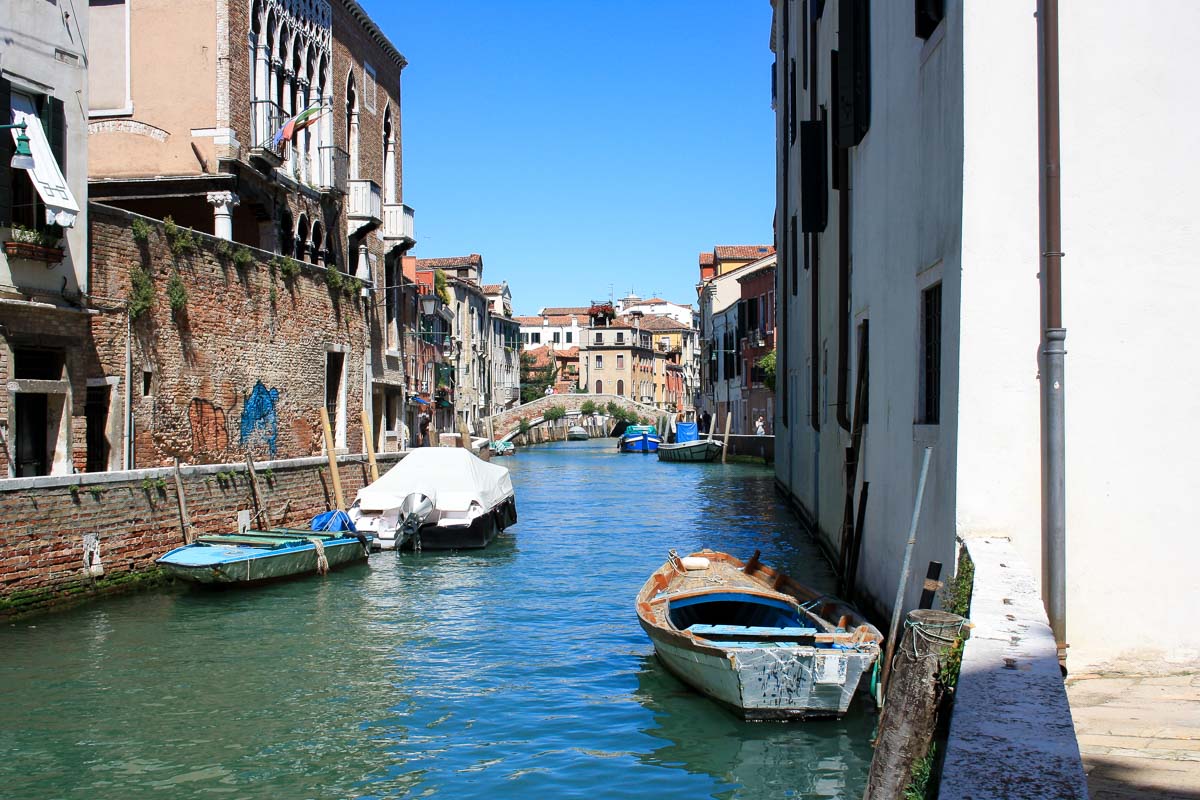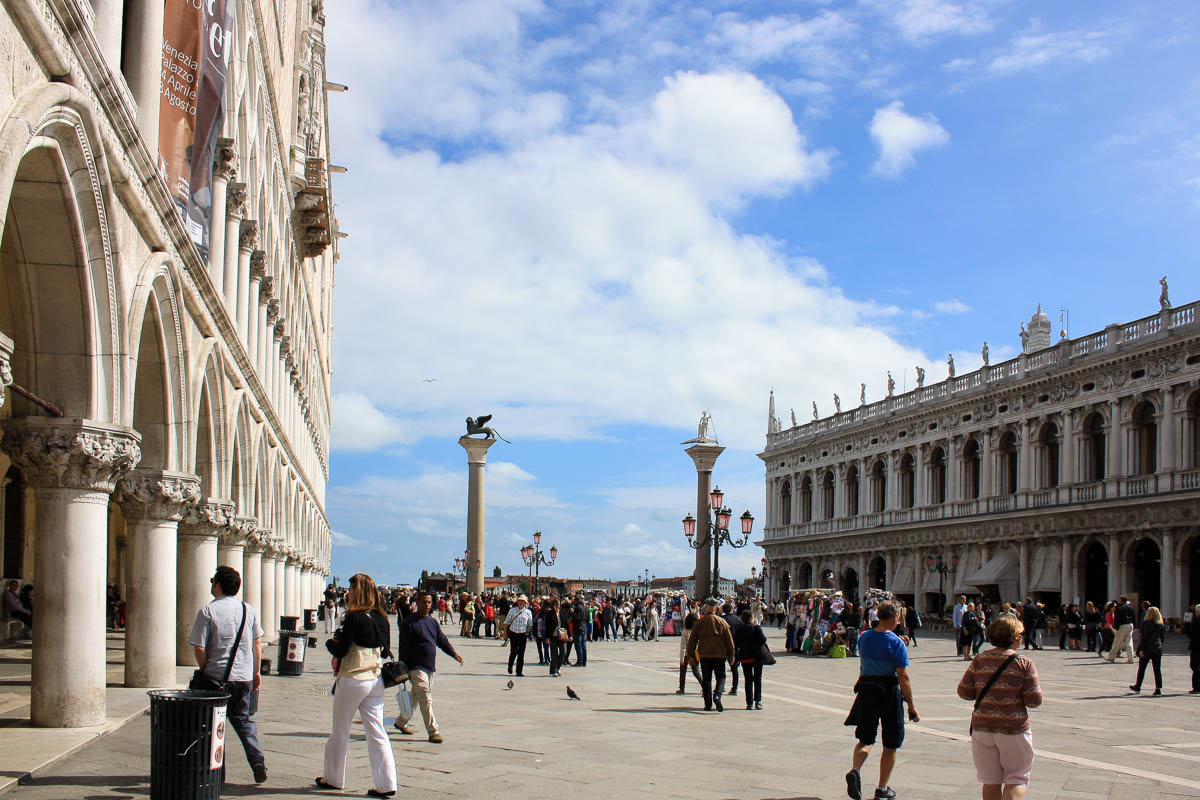Venice
Venice is a city full of history and romance. But at the same time: an amusement park full of people and false facades. Houses built on stilts. Canals that run through the heart of the city like veins of blood, supplying it with life. Tourists are the blood, tourists are the tumor that spreads and proliferates in a linear way. They are the only economic factor that keeps Venice alive, but they suck the city dry, taking away its charm, its authenticity, its uniqueness.
We traveled to Venice in 2013. A short vacation in May. Clouds and blue skies, lukewarm rain showers in the evening. We hadn’t been a couple for very long back then. Could there be a more beautiful place for us?



Our hotel is a cheap, unplastered house with an inner courtyard and a bathroom in the hallway. The walls of the room are thin, the beds no more than a rickety metal frame with a mattress. It has its charm and the red wine on the dwarfish balcony tastes all the better.
We push our way across the Rialto Bridge at a crawl through the crowd. Eternal love is promised to those who kiss under the bridge. We, on the other hand, are glad to have made it to the other side. Here, in the area of the bridge, is the center of the city. Along the Grand Canal are overpriced restaurants with unique views of the passing gondolas. The gondoliers wear striped jackets, hold the thin, long oars in their hands and steer lovers nestled close together to their hotels. Everything is a little too kitschy, too fake to be believed – if it weren’t for the thousands of tourists who keep pushing in front of the camera or bumping into us.





The splendor and importance of the former cosmopolitan city of Venice are channeled in the Doge’s Palace. A glamorous, richly decorated seat of government, perhaps the most beautiful building in the city. When the sun goes down, the shadow of the St. Mark’s Tower falls on the palace. We overlook Venice from the top of the tower. We see the bridges, the canals, the red roofs. We can see the island of San Giorgio Maggiore opposite. The bell tower of San Giorgio rises there as if it were the brother of St. Mark’s Tower.




The sun has gained the upper hand. It’s a gloriously warm May day. A huge cruise ship pushes its way into the port of Venice and vomits a heap of day-trippers. In 2013, the city counted 4.25 million tourist arrivals; ten years later, the figure is already 5.66 million. In the last twenty years, the number has more than doubled. How can a city deal with this when it is so dependent on tourism at the same time?
We stroll along the southern shore of the main island, Centro Storico. It’s a little quieter here. It’s easy to lose your orientation in the maze of alleyways. We order lasagne and wine for lunch. The lasagne is small and dry, the wine sour and tasteless. The price is too high. We have seen Venice. At least its façade. Venice is no longer a place where people can live and work. Where they want to raise their children or start a family in the first place. Venice is a Disneyland, a place for tourists. Luxury boutiques and souvenir stores have taken up permanent residence in the historic buildings. The city has sold its soul to cruise lines and is now paying the price: environmental destruction, overtourism, exploding property prices.
We have not found the true Venice, the Venice of its inhabitants and people. Perhaps it no longer even exists.



We are tired from all the walking on the last evening. Heavy clouds have gathered. We have settled down in Piazza San Marco with a bottle of wine from the supermarket. The day tourists have returned to their cruise ships and the cruise ships have gone out to sea. The threat of rain has driven the remaining people into their homes and hotels. A wind picks up and the streets are deserted. Just as we open our umbrellas as a precaution, the downpour starts. A warm, heavy rain falls on Venice. It’s still a long way to the hotel. There’s not much space under the umbrella – we both get wet. The street lights are reflected in the puddles and in the water of the canals; the city shimmers bluish-gold in the evening light. So lonely and so empty, Venice is a real gem.
Info about our trip
Venice attracts millions of visitors every year. For comparison: in 2023, the entire country of Thailand had just about five times as many tourist arrivals as the city of Venice. In the narrow streets and canals, the crowds squeeze together in a very small space. Added to this are the cruise ships, which contribute to a particularly harmful and unsustainable form of tourism. The city council is constantly testing new strategies to deal with the situation. It recently introduced an “entrance fee” of 5 euros.
Nevertheless, Venice is a beautiful city. The best advice would be to travel to Venice in winter to avoid the crowds of tourists. But a city trip in lousy, Central European weather is really no fun. So there’s no way around it: If you want to see Venice, throw yourself into the fray – perhaps at least in the low season in fall or spring.
Where there are tourists, quality suffers and prices rise. Venice is an expensive city and rightly so. We believe that the city can only get rid of its image as an overcrowded mass tourist city if it massively restricts cruise tourism, for example, and perhaps focuses more on class than on mass. Either way, fill up your bank account before you travel to Venice.
Back then, we were poor students visiting Venice. However, in 2013 you could still fly to Italy for a few euros with Ryanair. In any case, we saved on food wherever we could. The few restaurants we visited delivered pretty poor quality (it’s definitely not true that you can eat good pizza anywhere in Italy). The lasagne was small and dry, the pizzas had poor toppings. Our breakfast often consisted of crêpes from the waffle stand and, in a pinch, we sometimes had wine from a tetrapack from the supermarket (yes, certainly a sin of youth). We are sure that there are also good restaurants in Venice, but the desired quality certainly has its price.
We stayed at the Albergo Minerva e Nettuno back then. One night costs less than 100 euros, for which you get a slightly run-down, very simple, impersonal room without a private bathroom. In return, you are close to the train station, but far from the city center (but you can walk). We can’t really recommend this hotel unless you’re looking for cheap accommodation in Venice.
In general, Venice is a fairly safe city. The biggest risk is the usual pickpocketing by petty criminals. So take good care of your valuables. It’s best to pack them close to your body or even better: under your jacket/under your T-shirt.
Phew, Venice with children? It’s certainly possible and maybe even fun for the kids. But we imagine the whole thing to be stressful for the parents: Children eat a lot and want souvenirs. That can be expensive in Venice. Then you also have to keep an eye on the kids in the hustle and bustle … It’s not always possible to walk with a baby stroller – there are always bridges or narrow passages to cross. And finally, your child should enjoy churches, gondolas and Gothic buildings such as the Doge’s Palace.
You can get to Venice by every conceivable means of transportation: by plane (but not directly, you’ll have to take a bus also), train, coach or car – but only as far as the city gates. On the islands of Venice, you can then walk – or pay a pretty penny to be rowed through the canals by a gondolier.
- For children, Cornelia Funke’s Lord of the Thieves is certainly a nice preparation for a trip to Venice
- A German classic par excellence: Death in Venice by Thomas Mann
- Hermann Hesse also dedicated himself to the city in Lagunenzauber: Aufzeichnungen aus Venedig
